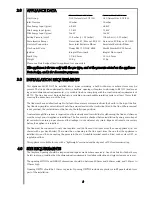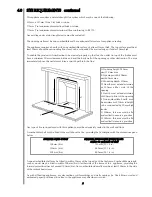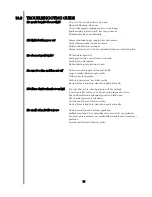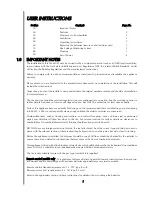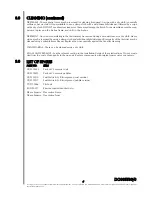
OPERATING TTHE FFIRE ((Remote ccontrol vversions)
continued
The remote control unit allows operation of the main burner between maximum and
pilot only setting. It does not turn the pilot on or off.
The remote control handset incorporates an inbuilt safety feature to prevent the
main burner being activated or turned up accidentally. It is necessary to press but-
ton 1 and 2 (see illustration) simultaneously to turn the fire up.
To turn the fire down press button 3 only.
SPARK FAILURE
The gap between the spark electrode and the pilot should be 3.5 - 4.5mm to pro-
duce a good spark. There should be no need to adjust this. If under any circum-
stances the electric spark fails, the pilot may be lit manually by proceeding with the
ignition sequence as previously described, and after turning the control knob
through the spark position, the knob should be held in and the pilot lit with a taper.
SETTING PRESSURE
Remove the screw from the pressure test point.
Manual control versions - The pressure test point is situated on the main injector pipe next to the pilot.
Remote control versions - The pressure test point is located directly above the gas control.
Attach a U gauge. Light the fire on the HIGH setting.
The setting pressure should be in accordance with the figures stated on page 2 of these instructions. The fire is
factory set to achieve these pressures, and any significant variation could indicate a supply problem.
If the pressure is too high, the gas supply meter may be set incorrectly. This should be checked with the fire run-
ning and if necessary reset by the gas supplier.
If the pressure is too low, then check the meter governor pressure with the appliance running. If this is incorrect
it will need to be reset by the gas supplier. If the setting pressure is too low, but the meter pressure is acceptable,
then a problem in the supply pipework is to be suspected. This will be dirt and debris, kinked or inadequate size
pipes, restriction in a fitting or solder flashing across a joint. (NOTE: you will not get an accurate reading of the
inlet pressure with a pressure gauge on the end of the supply pipe - this is the static pressure in the system. You
must use a T piece and measure the supply pressure with the fire on High - the dynamic pressure). Refit and tight-
en the screw into the pressure test point when the test is complete.
FLUE SPILLAGE MONITORING SYSTEM
This fire is fitted with a flue spillage safety device (ODS). If the fire shuts down during use for no apparent reason
then several things may be suspected. If a door or window has been opened creating a draught, then pilot dis-
turbance is the problem, and removal of the draught should resolve this. If a grommet seal has been left out of
the firebox then this also will also cause intermittent shutdown. The gas pressure reaching the fire must also be
checked. The thermocouple connection into the back of the gas control valve may also have worked loose dur-
ing installation, simply tighten to remedy if this is the case.
If pilot disturbance is not the cause, then the ODS safety system may be in operation. Switch the appliance OFF,
check the flue and carry out any remedial work required. Relight the fire and carry out a spillage test. DO NOT
allow the appliance to be used if it continues to fail a spillage test.
The aeration hole of the pilot must be carefully cleaned out on each annual service to ensure contnued function
of the ODS.
The spillage monitoring system shall not be adjusted, modified, or put out of operation by the installer. Any spare
parts fitted MUST be of a type supplied for the purpose by the appliance manufacturer.
If the fire is not spilling, then further guidance should be sought, using the Troubleshooting section as a guide.
13
11
22
33
14.2
14.3
14.4
14.5




